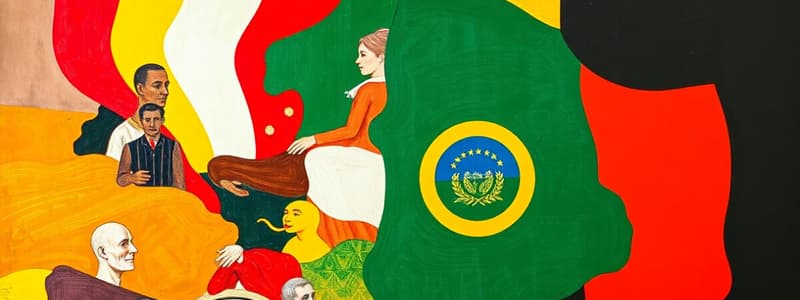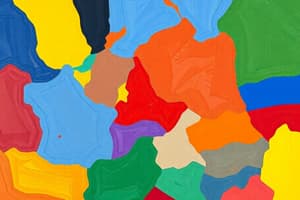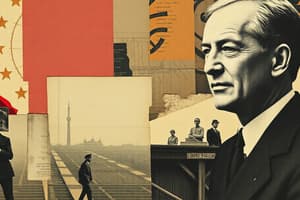Podcast
Questions and Answers
Explain how Napoleon Bonaparte played a crucial role in unifying France, highlighting the key actions he took and their impact on fostering a national identity.
Explain how Napoleon Bonaparte played a crucial role in unifying France, highlighting the key actions he took and their impact on fostering a national identity.
Napoleon Bonaparte promoted patriotism, formed a national army, and reduced the power of the Catholic Church, contributing to a unified French identity by fostering a sense of shared purpose and allegiance to the nation rather than religious institutions.
Discuss the impact of industrialization on the formation of a national identity in France, highlighting the ways in which it brought people together and contributed to a sense of shared experience.
Discuss the impact of industrialization on the formation of a national identity in France, highlighting the ways in which it brought people together and contributed to a sense of shared experience.
Industrialization connected communities through train networks and factories, leading to the growth of urban centers where people from diverse backgrounds interacted, shared experiences, and developed a sense of belonging to a larger national community.
Explain how the development of a national school system in France contributed to a unified national identity. What were the main objectives of this system, and how did it achieve them?
Explain how the development of a national school system in France contributed to a unified national identity. What were the main objectives of this system, and how did it achieve them?
The national school system aimed to spread the French language and instill national pride among students. It achieved this by providing standardized education across the country, promoting a shared understanding of history, culture, and national values, and unifying diverse populations under a common framework.
Compare and contrast the role of top-down efforts by the state and bottom-up cultural changes in the emergence of a modern French identity in the 19th century. Provide examples of each type of influence.
Compare and contrast the role of top-down efforts by the state and bottom-up cultural changes in the emergence of a modern French identity in the 19th century. Provide examples of each type of influence.
Discuss the impact of the idea of the nation on revolutions and unification movements across Europe in the 19th century. How did the concept of national identity contribute to these events?
Discuss the impact of the idea of the nation on revolutions and unification movements across Europe in the 19th century. How did the concept of national identity contribute to these events?
Explain the challenges faced in forming a unified Italian identity after Italy's unification in 1861 and how these challenges were addressed in the latter half of the 20th century.
Explain the challenges faced in forming a unified Italian identity after Italy's unification in 1861 and how these challenges were addressed in the latter half of the 20th century.
Describe the link between the creation of new nations in Europe based on ethnic nationalism and the tensions that led to World War I. How did the emphasis on ethnic identity contribute to the outbreak of war?
Describe the link between the creation of new nations in Europe based on ethnic nationalism and the tensions that led to World War I. How did the emphasis on ethnic identity contribute to the outbreak of war?
Explain how the redrawing of borders after World War I, based on the idea of the nation, contributed to the rise of nationalist movements and the eventual outbreak of World War II.
Explain how the redrawing of borders after World War I, based on the idea of the nation, contributed to the rise of nationalist movements and the eventual outbreak of World War II.
Analyze the potential dangers of a concept of nationhood built solely on shared ethnicity. How can it be used to justify persecution, discrimination, and nationalist extremism?
Analyze the potential dangers of a concept of nationhood built solely on shared ethnicity. How can it be used to justify persecution, discrimination, and nationalist extremism?
Describe the key factors that contributed to the global spread of the idea of the nation, highlighting how they facilitated its influence beyond Europe.
Describe the key factors that contributed to the global spread of the idea of the nation, highlighting how they facilitated its influence beyond Europe.
How does the text argue that the concept of a nation is fundamentally flawed?
How does the text argue that the concept of a nation is fundamentally flawed?
Identify and explain one of the potential solutions the text suggests to the problem of national identity?
Identify and explain one of the potential solutions the text suggests to the problem of national identity?
Provide two examples from the text of how national identities can change and how these changes might be viewed differently by different groups within a nation.
Provide two examples from the text of how national identities can change and how these changes might be viewed differently by different groups within a nation.
Explain two of the sources from which individuals derive their sense of identity and community, as stated in the text.
Explain two of the sources from which individuals derive their sense of identity and community, as stated in the text.
How does the text relate the concept of the “enemy” to national identity and the potential for conflict?
How does the text relate the concept of the “enemy” to national identity and the potential for conflict?
Why does the text consider borders to be “constructed and artificial” and how does their artificiality impact people’s lives?
Why does the text consider borders to be “constructed and artificial” and how does their artificiality impact people’s lives?
In addition to national identities, how does the text suggest that individuals can find identity beyond the nation? Explain two examples.
In addition to national identities, how does the text suggest that individuals can find identity beyond the nation? Explain two examples.
What are the limitations of the nation-state model, according to the text?
What are the limitations of the nation-state model, according to the text?
Explain how the text connects the concept of borders to the broader theme of artificiality in social constructs?
Explain how the text connects the concept of borders to the broader theme of artificiality in social constructs?
What are the potential drawbacks of a strong national identity, and how can these drawbacks be mitigated?
What are the potential drawbacks of a strong national identity, and how can these drawbacks be mitigated?
Study Notes
The Nation: A Made-Up Concept
- The concept of a nation, a country unified by heritage and identity, is relatively recent.
- Countries are not inherently natural; they are not based on shared ethnicity or language alone.
- The borders of countries like France have changed throughout history, and populations haven't always shared a uniform culture or ethnicity.
- Even in ancient empires like China, most people ruled did not share the same language or culture as the ruling elites.
Rise of the Nation-State
- The French Revolution, while promoting citizen sovereignty, did not immediately create a unified French identity.
- Napoleon Bonaparte significantly unified France through patriotism, a national army, and weakening the Catholic Church.
- Industrialization fostered unity by connecting communities via trains and factories, drawing people to urban centers.
- A national school system promoted French language and national pride, contributing to a more unified national identity.
- A modern French identity developed gradually, combining top-down state efforts with bottom-up cultural transformations by the 19th century.
Spread of Nationalism
- Napoleon's actions spread the nation-state concept across Europe, impacting revolutions and unification movements.
- Italy unified in 1861; however, a unified Italian identity took decades to establish, facilitated by national education and 1960s television broadcasting.
- The creation of new nations based on ethnic nationalism in Europe contributed to World War I tensions.
- Post-WWI border adjustments frequently included ethnic minority groups, fueling nationalist movements that contributed to WWII.
The Perils of Nationalism
- Nations based on ethnicity can lead to minority persecution and nationalist extremism.
- Fascism, a 20th-century phenomenon, is an example highlighting how a distorted understanding of national identity can result in atrocities and oppression.
Globalization of the Nation
- The nation-state concept spread globally due to improvements in transportation, communication, and colonization.
- Formerly divided communities united under a shared national identity, often to achieve independence.
- The nation-state model, emphasizing firm borders, centralized governments, and national pride, became the dominant global political structure.
National Identity and It’s Imperfections
- The nation-state concept is flawed, creating divisions and conflicts because it expects everyone to fit within a single national identity, failing to consider the fluidity of personal identities.
- Disagreements over territory, belonging, and decision-making power arise from this flaw.
- Nationalistic ideals often contribute to global conflicts.
Expanding Identity and Beyond
- National identities evolve: France is increasingly accepting individuals regardless of race, religion, or birthplace, but this also faces resistance from those upholding traditional views of French identity.
- Expanding beyond territorial national identity offers a solution, such as the concept of a collective European identity, avoiding the exclusion, competition, and potential for war inherent in stricter nation-state boundaries.
- Cosmopolitan identity embraces global connections and cultural diversity.
Finding Identity Beyond The Nation
- Individuals derive identity and community from multiple sources: including religion, professions, local communities, and global connections.
- Creating a national "us" versus "them" identity clashes with an inclusive "shared values" model promoting societal participation.
The Importance of “Us” and “Them.”
- Humans often utilize "us" vs."them" dynamics to establish identity, building unity in the face of perceived enemies.
- Acknowledging this psychological tendency necessitates conscious efforts towards more inclusive and peaceful community building.
- Nations are not fixed entities; they constantly adapt as human understanding evolves.
- Peaceful navigation of the nation concept requires balancing individual identities with encouraging global unity.
The Concept of Borders
- Borders are constructed and arbitrary, yet they significantly affect people's lives.
- This reflects a broader channel theme examining the artificiality of borders along with the social impacts.
Studying That Suits You
Use AI to generate personalized quizzes and flashcards to suit your learning preferences.




